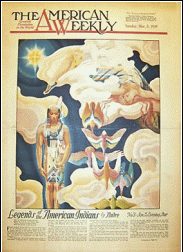Dick writes in his 1968 "Self-Portrait, "And then there was the lurid section of the Hearst newspapers which on Sunday told of mummies still alive in caves, and lost Atlantis, and the Sargasso Sea. The American Weekly, this quasi-magazine was called. Today we would dismiss it as “pseudo-science,” but in those days, the mid-thirties, it was quite convincing. I dreamed of finding the Sargasso Sea and all of the ships tangled up there, their corpses dangling over the rails and their coffers filled with pirate gold. I realize now that I was doomed to failure by the very fact that the Sargasso Sea did not exist -- or anyhow it did not capture many Spanish gold-bearing ships-of-the-line. So much for childhood dreams."
Pictured above is the two-page spread about the Sagrasso Sea from The American Weekly, March 5, 1939 edition.
So here in this important early influence on PKD we have a very early example of "fake news." But The American Weekly is not Fox News or MSNBC using their infrastructure to perpetuate a partisan rhetorical bubble. The American Weekly traded on its journalistic reputation every Sunday, flipping the relationship between "truth" and "fiction" in the attempt to squeeze money out of their readers by capitulating to the luridness of their imagination. As Robert Anton Wilson famously said, "Reality is what you can get away with."


No comments:
Post a Comment